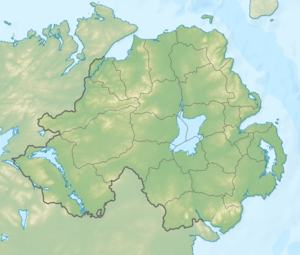1970 RUC booby-trap bombing
| Crossmaglen booby-trap bombing | |
|---|---|
| Part of the Troubles | |
 | |
| Location | Crossmaglen, County Armagh, Northern Ireland |
| Coordinates | 54°7′55.72″N 6°34′57.10″W / 54.1321444°N 6.5825278°WCoordinates: 54°7′55.72″N 6°34′57.10″W / 54.1321444°N 6.5825278°W |
| Date |
11 August 1970 12:30 a.m. |
| Target | Royal Ulster Constabulary personnel |
Attack type | booby-trap bomb |
| Deaths | 2 RUC officers |
| Perpetrator | Provisional IRA (South Armagh Brigade) |
On 11 August 1970, two Royal Ulster Constabulary (RUC) officers were killed by a booby-trap bomb planted under a car by the Provisional Irish Republican Army (IRA) near Crossmaglen, in County Armagh, Northern Ireland. [1][2][3] They were the first RUC officers to be killed by republicans during the Troubles and the first security forces to be killed in South Armagh, an IRA stronghold for much of the conflict.
Background
The conflict known as Troubles had started a year earlier in August 1969 with the Battle of the Bogside followed by the August 1969 riots. The first RUC officer to be killed in the conflict was Victor Arbuckle (29). He was shot dead by members of the Ulster Volunteer Force (UVF) on 12 October 1969, during street violence in the Shankill area of Belfast. The loyalists "had taken to the streets in protest at the Hunt Report, which recommended the disbandment of the B Specials and disarming of the RUC".[4]
The bombing
On the evening of 11 August, two RUC officers based in Crossmaglen—Samuel Donaldson (23) and Robert Millar (26)[5]—went to investigate a red Ford Cortina abandoned on the Lissaraw Road near the village. Unknown to the officers, the car contained a booby-trap bomb, made up of 20 lb (9.1 kg) of gelignite. It exploded when one of the officers attempted to open one of the car doors, badly wounding them and blowing them over a hedge. The blast was heard from Crossmaglen RUC station. The officers died of their wounds the next day. They were the first members of the security forces to be killed by republicans during the conflict.[6][7] The car had been stolen outside the Ardmore Hotel in Newry on 7 August. The action was planned and executed by an active service unit made up of IRA members from Navan, County Meath and Inniskeen, County Monaghan, both in the Republic of Ireland. The group was led by high-profile republican Seán Mac Stíofáin.[8]
Aftermath
On the same day as the bombing thousands of people including Gerry Adams attended the funeral of veteran IRA man Jimmy Steele who fought in the Irish Civil War for the Republican side, and was buried in Milltown cemetery [9]
The next killing of a member of the British security forces was in February 1971, when the IRA shot dead Gunner Robert Curtis in Belfast. Curtis was the first British soldier to be killed in the Troubles.[10]
Crossmaglen would become an Irish Republican stronghold and the Provisional IRA carried at many attacks on the British security forces here during the course of the conflict. See: The Troubles in Crossmaglen
See Also
- Drummuckavall Ambush
- The South Armagh Sniper
- Glasdrumman ambush
- Operation Conservation
- Attack on Cloghogue checkpoint
References
- ↑ "Army and police casualties". 19 December 1975. Retrieved 3 July 2017.
- ↑ "Gravestones book tribute to 302 RUC members". Belfat Telegraph. 10 May 2011. Retrieved 3 July 2017.
- ↑ "Police Roll of Honour Trust". Retrieved 3 July 2017.
- ↑ McKittrick, David. Lost Lives: The Stories of the Men, Women and Children who Died as a Result of the Northern Ireland Troubles, Random House, 2001. p. 42
- ↑ Sutton, Malcolm. "CAIN: Sutton Index of Deaths". cain.ulst.ac.uk. Retrieved 17 May 2017.
- ↑ McKittrick, pp.56-57.
- ↑ Sutton, Malcolm. "CAIN: Sutton Index of Deaths". cain.ulst.ac.uk. Retrieved 17 May 2017.
- ↑ Harnden, Toby (1999). Bandit Country. The IRA & South Armagh. Coronet Books. p. 56. ISBN 0340717378.
- ↑ Peter Taylor - Behind The Mask: The IRA & Sinn Fein p.106
- ↑ Sutton, Malcolm. "CAIN: Sutton Index of Deaths". cain.ulst.ac.uk. Retrieved 17 May 2017.